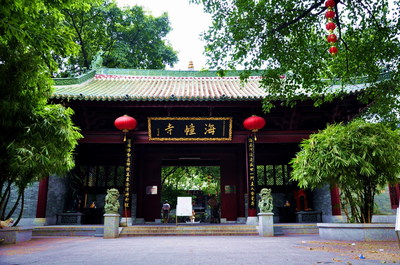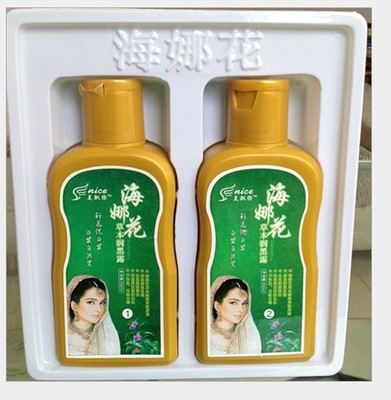海幢寺始建于南汉时期(公元907年~971年),迄今有一千多年历史,是广州市重点文物保护的寺院。它以寺貌庄严、殿宇雄伟、高僧辈出面(而)闻名于世,被誉为广州市“五大丛林”之一。
据史料记载:本寺南汉时期为千秋寺。后来由于历史原因,被废为民居。明朝末年,为富绅郭龙岳的园地。时有光牟、池月二位法师,向郭氏募得此园,建造寺院,并依《华严经》经文中“海幢比丘潜心修习般若波罗密多心经成佛”之意,以海幢比丘的名字,取名海幢寺。
清初有曹洞宗第三十三祖空隐大师主持此寺,天然大师(三十四祖)、阿字大师(三十五祖)先后在此住(主)持弘法。永历皇帝旧臣金堡,也在此出家,法号今释,又名澹归。当时阿字和尚得到平南王尚可喜的支持,购地扩建寺院。在康熙期间寺院不断扩建,最鼎盛时期,住僧众逾百。寺院规模宏大,全寺范围,北至珠江之滨,东及前进大街;南沿万松岭(今红十字会医院、南武中学一带)。清代海幢寺全盛时,既是弘扬佛法之所,也是广州市民游春胜地之一。
清光绪初年,海幢寺日渐式微,东北旷地也变为民居。至清末民初,由于战乱,文物古迹遭严重破坏,除大雄宝殿、天王殿、塔殿外,其余殿宇多被拆毁。民国十七年(1928年),海幢寺被没收并辟为“河南公园”。民国二十二年九月(1933年),又改名为“海幢公园”。然而,海幢寺院宗教活动一直没有停止。解放后,在十年文革的活劫中,海幢寺再次遭到严重的破坏。
一九九三年,根据国家宗教信仰自由政策,经广州市人民政府批准恢复海幢寺为宗教活动场所,并被确定为广州市文物保护单位。海幢寺在终止宗教活动三十年后又重获新生。寺院恭请德高望重的新成法师出任本寺住持。新成大和尚接管本寺之后,发(决)心为重兴海幢寺而劳苦奔波,在短短几年之内,就修复大雄宝殿、塔殿,并重建天王殿、藏经阁、念佛堂、及七层僧寮,重塑三宝大佛及四大天王金身,使海幢寺重现大丛林的气派。
一九九三年以后,由于历史原因,海幢寺与海幢公园同园,海幢寺只占园中西侧,因而失去佛教寺院应有的对称和平衡,也给寺院的管理造成很大的困难。经新成大和尚及市、区各界人士多年不懈努力,终于在二00六年七月一日,经广州市、海珠区人民政府年批准将公园归为海幢寺管理使用,使历经百年沧桑的海幢寺恢复历史本来面目,迈进了历史上又一兴盛时期,功德无量。
本寺以佛法,为修持宗旨;以丛林清规,为管理法规;以慈善救济,回报众生;以佛法教化,创建和谐社会。

地址:广州市海珠区南华中路188号
开放时间:上午7:00—下午5:00
电话:020—34376882
Brief Introduction of Haizhuang Temple
Haizhuang Temple was built in the Southern Han Dynasty(AD 907 ~ 971 years),which has 1000 years of history. It is the key cultural preservation of the temple. It is well known for Temple Maung solemn, majestic temples, famous monks come forth in large. It is praised one of the Buddhism Five Jungle.
According to historical records: during the Southern Han Period, it was called Qianqiu Temple. Later, due to historical reasons, it has been spent as a residence. At the end of Ming Dynasty, it was the Fusion Guo Yue’s garden. At that time, there are two Master: Guangmou; Chiyue. This park was procured from Kwok, and then built. And according to the "Sutra" scripture:" A monk named Bhikkhu from the Haizhuang Temple, which devoted himself to attend Prajna Paramita Heart Sutra Buddha," so In his name to name of the Temple.
At the beginning of Qing Dynasty, CaoDong zong, presided over the temple, who was the 33rd generation of Kong Yin master. They have presided over the Dharma Talk in the temple. Jin Bao, Yongli Emperor’s a former minister, is also a monk in the temple. His posthumous Buddhist name is Jin shi, also known as Zan Gui. At that time, A Zi purchased the land, and expanded the monastery, with the help of the Rajah, Shang Kexi. The temple was expanded continuously during the reign of Emperor Kangxi. The most flourishing time, more than 100 monks lived there. Large-scale temple, To the north shore is Pearl River, to the East is the QianJin street; to the south is the Wan Songling (Nowadays is the region of Red Cross Hospital﹑
NanWu high school).At the peak of the temple, the temple was not only promoting the Buddhist doctrine, but is also one of the Guangzhou people’s spring resort.
The early years of the Emperor Kuang Hsu of Qing dynasty, Haizhuang Temple slowly faded down; the Northeast of it was also open areas into residential areas. At the end of Qing Dynasty, and the early Republican, since the war, cultural relics and monuments were severely damaged. Except for the Main Hall, Heavenly King Hall, outer wall of tower mall, the rest of it had been demolished. In seventeen years of Republican (1928), it was confiscated and opened as the "Henan Park". In the September of twenty-two years, It also changed its name to “Haizhuang Temple ", However, its religious activities had never stopped. After liberation, during the Cultural Revolution, the Haizhuang temple was severely damaged again.
In 1993, according to the national policy of religious freedom by the Guangzhou Municipal People's Government, approved the resumption of the Haizhuang temple buildings for religious activities, and was identified as heritage conservation units in Guangzhou City. The Haizhuang Temple Obtained a new development after 30 years’ termination of religious activities. The new monastery invited into the Master respected as the abbot of this temple。The XinCheng monks took over this temple, and determined to promote the temple, he worked hard. In just a few years, he repaired the Main Hall, Tower Hall, reconstructed the kings Hall, depositary of Buddhist texts, Buddhism Church, and the seven monks Laos, remodeled Sambo Buddha and the four open-Wang’s golden body, it made Haizhuang Temple reproduce the large jungle style.
The temple’s purpose is promoting the Buddhism; Management regulations is a jungle Kimono; Returning to the society is Charitable relief; to Buddhist enlightenment, create a harmonious society.
After 1993, due to historical reasons, it only occupied the west side of the garden, the Haizhuang temple and the Haizhuang park in the same park, Thus lost the Buddhist monasteries’ symmetry and balance, but also caused great difficulties to the management of temple. With the Da Cheng monk and all walks of people’s work from the district, city, finally in July 1, 2006, by Guangzhou City, Haizhu District People's Government approved that the park as one part of Haizhuang temple and used it. So that after a century of vicissitudes of the Haizhuang temple restored the historical truth by saying that, Forward in the history of another boom period, the boundless beneficence.
Address: Nanhua Middle Road, Haizhu District, Guangzhou
Opening Time: 7:00 am – 5:00 pm
Tel: 020—34376882
海幢寺案内
海幢寺は南漢時期(西暦紀元907年~971年)に建て初め、いままでもう千年歴史を持っていて、広州市より保護された重点的な寺である。海幢寺は姿が厳かでしめやかで、殿宇が雄大で、高僧が続々と輩出したにより、世に広くその名を知られるようになりました。広州市「五大僧林」の一つとされる。
歴史の資料によると、海幢寺は南漢時期で千秋寺をともいう。後来、歴史の原因ため、普通の住宅にけなした。明の末年になって、海幢寺は金持ちの郭竜岳の庭園になった。そのとき、名は光牟、池子という二つの法師は、郭氏からこの庭園を得てもらって寺をつくた、そして《華厳経》の中の「海幢比丘潜心修習般若波罗密多心经成仏」この聖句の意味を引用して、海幢比丘の名で海幢寺に名付けた。
清の初め、曹洞宗第33祖空隠禅師は海幢寺の主持となって、天然禅師(34祖)、阿字禅師(35祖)は前後してこの寺で仏法を発揚したことがあった。永歴皇帝の旧臣の金堡もこの寺で仏門に入って、法名は今释をという、また澹归をともいう。そのとき、阿字和尚は平南王の尚可喜から支持を得てもらって土地を購買して寺を拡張させた。康熙期間、寺は引き続き拡張されていて、寺の真っ盛り期間、この寺で仏門に入った僧たちは百名以上に達した。寺の規模は非常に大きい、北は珠江のほとりまで、東は前進大通りまで、南は万松岭(赤十字会病院、南武中学一帯)に沿う。清の海幢寺の全盛期は、仏法を発揚するだけでなく、広州市民にとって春のピクニックの遊覧地の一つである。
清の光緒の初め、海幢寺は衰えて日一日と勢力がなくなっていて、東北においての空き地は普通の住宅にけなした。清末民初、戦乱により、文物旧跡が重大な損失を被った、大雄宝殿、天王殿、塔殿を除き、ほかの殿宇はほとんどが取り壊された。中華民国17年(1928年)、海幢寺は没収されて、「河南公園」に改造された。中華民国22年9月(1933年)、名前が「海幢公園」に変更された。しかし、海幢寺に催した宗教活動はずっと行っている。解放後、10年間続いた文化大革命により、海幢寺は再び重大な損失を被った。
1993年、国家の宗教信仰自由政策に基づき、広州市人民政府の許可を取得して、海幢寺が宗教活動場所である身分を回復した、そして広州市文物保護単位に確定された。海幢寺は宗教活動を30年中止された後、やっと新しい生命が始まった。寺は徳望が高い新成法師を招請して住持を担当する。新成法師は本寺を接収管理した後、海幢寺を振興するために、苦労して奔走しております、わずか数年間で大雄宝殿、塔殿を修復した、天王殿、藏経閣、念仏堂、七層僧寮、三宝大仏及び四天王を再建した、海幢寺に僧林の気風を再現させた。
歴史の原因ため、1993年以後、海幢寺と海幢公園とは同じ場所にあり、海幢寺はただ園の中の西側に占めて、そのため海幢寺は仏教寺院としての対称とプランスを失った、これで寺の管理に大きな困難をもたらした。新成法師及び市、区の各界の人々の何年間のたゆまない努力によって、やっと2006年7月1日に海幢公園を海幢寺の管理使用に帰属させると広州市、海珠区人民政府より許可された、幾たびか世の転変を経た海幢寺を本来の様子に回復させて、歴史上のもう一つの全盛期に入った、功徳が非常に大きい。
海幢寺は仏法を修行趣旨として、僧林戒律を管理法規として、慈善で救済して衆生に報いる;仏法で教化してなごやかな社会をつくる。
住所:広州市海珠区南華中路(記:これは寺の玄関である)
営業時間:午前7:00—午後5:00
電話:020—34376882
 爱华网
爱华网


